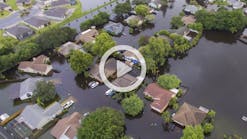About the author:
Tanya Bilezikjian, P.E., is a senior associate with RBF Consulting. Bilezikjian can be reached at [email protected].
The multitude of roles and responsibilities required by the 2009 California Construction General Permit for Stormwater (CGP) has created an environment of potential conflicts of interest among involved parties when a typical contract setup is used. The CGP defines specific roles for the project owner, storm water pollution prevention plan (SWPPP) developer, SWPPP practitioner and contractor.
In practice, the permit-defined roles are filled by a variety of parties, and change with each project. A perfect solution—one that balances cost, risk, compliance and responsibility—has not often been found. The two primary parties on any project are the owner and the contractor. A project owner wants a project completed on time at the lowest cost with the least exposure to risk of regulatory attention or enforcement. A construction contractor’s goal is to complete the project in the least amount of time in order to maximize profit. Because the project owners’ and the contractors’ goals do not exactly coincide, the potential for conflict is present. Looking at just these two parties, it is easy to wonder which party is best suited to employ the SWPPP developer and practitioner.
A classic project structure calls for a general contractor and a project owner, with the contractor taking responsibility for compliance with the CGP (writing the SWPPP, conducting the onsite inspections, installing and maintaining BMPs, reporting) and the project owner applying for permit coverage and certifying compliance. The CGP—with its focus on defined roles, assigned responsibility, specificity and enforceability—has changed the status quo and left project owners and contractors more vulnerable to regulatory action due to the greater enforceability of the CGP.
Conflict-of-interest situations will vary depending on the relationships between all parties and the structure of the contract, and may most appropriately be recognized by the classic phrase, “I’ll know it when I see it.” Consider the following scenarios, each of which sets up a different conflict between the parties.
Conflict Scenarios
Scenario 1. Contract transfers enforcement risk to the contractor may lead to the following:
- Contractor is now on the hook for fines; and
- Contractors may gamble on skimping on storm water implementation to save costs, betting that enforcement is a vanishingly small possibility.
In this situation the project owner is still responsible for responding to any enforcement, which may require costs, liability and effort above what is acceptable, and also will include negative public perception and a damaged reputation with a regulatory agency. It also can be costly to recover penalties from the contractor. However, regulators now have begun to name contractors in enforcement actions, regardless of whether the contractor is a permit holder.
Scenario 2. When a project owner hires SWPPP developer and practitioner, the following issues may arise:
- A third-party practitioner typically lacks the authority to direct the contractor to work or spend money; and
- A third-party developer and/or practitioner will want to keep the client happy by being protective of the owner’s interests, but potentially at higher cost to contractor and owner.
In this situation the project owner likely has excellent documentation of SWPPP implementation, but field compliance may be lacking if the contractor does not adhere to recommendations.
Scenario 3. When a contractor hires SWPPP developer and practitioner, the following are likely to occur:
- Most jobs are awarded based on the lowest bid; but
- High-quality implementation of a SWPPP can rarely be accomplished using the lowest bidder.
In this situation the project owner is on the hook for compliance while having no control over implementation
Scenario 4. When a contractor bids on storm water management as a lump sum, the following may occur:
- There may be no provision for purchase of additional BMPs;
- The price for purchasing and installing additional BMPs may not be specified; and
- The contractor may be unwilling to spend the full lump sum amount on SWPPP implementation, instead assuming that each BMP not installed is more cash in the profit column at the end of the job.
In this situation the project owner has the choice of paying directly for purchase of BMP consumables and installation, or signing change orders. The project owner also lacks control over costs.
Bottom Line
Although there is no single best solution, there are methods that can minimize the risk and cost of construction site storm water management. The best solutions include careful attention to contract language and a precise project scope that includes a bid item for BMPs that must be renewed through the life of the project—such as silt fence and erosion control applications.
Ideally, the owner or employees of the owner would serve as SWPPP developer and practitioner for a project, allowing the owner to balance the risks of non-compliance with the costs of compliance. If the owner or his/her staff do not have the technical background to administer the CGP, the next best approach is for the owner to hire an independent consultant to complete the SWPPP and implement it in the field. It can be difficult for different personnel to develop the SWPPP and implement it; ideally, both of these responsibilities belong to the same entity.
The least preferred approach is to require the contractor to develop and implement the SWPPP. This can be a reasonable approach on low-risk projects, or when the project owner uses a construction management firm that retains oversight on the project.
The bottom line is that responsibility for compliance rests with the project owner. The owner delegates responsibility for compliance to others at his potential peril. A knowledgeable team with a high level of trust is needed to complete a project at a reasonable cost.
Download: Here






